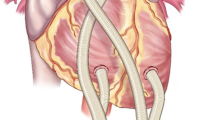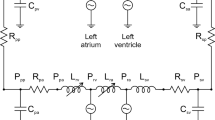Abstract
A model of the cardiovascular system is presented. The model includes representations of the left and right ventricles, a nonlinear multielement model of the aorta and its main branches, and lumped models of the systemic veins and the pulmonary circulation. A simulation of the intra-aortic balloon pump and representations of physiological compensatory mechanisms are also incorporated in the model. Parameters of the left ventricular model were set to simulate either the normal or failing canine circulation. Pressure and flow waveforms throughout the circulation as well as ventricular pressure and volume were calculated for the normal, failing, and assisted failing circulation. Cardiac oxygen supply and consumption were calculated from the model. They were used as direct indices of cardiac energy supply and utilization to assess the effects of cardiac assistance.
Similar content being viewed by others
Abbreviations
- A m :
-
vessel cross-sectional area atm mmHg
- E :
-
ventricular pressure-volume ratio
- E max :
-
maximum value ofE
- E n :
-
normalizedE function
- E w :
-
vessel wall elastance
- P :
-
blood pressure
- P AV0 :
-
unperturbed mean aortic root pressure
- P AV :
-
mean aortic root pressure
- P im :
-
intramyocardial pressure
- P LV :
-
left ventricular pressure
- P VL :
-
pressure across aortic valve
- P V :
-
systemic venous blood pressure
- PVA :
-
pressure-volume area
- P W :
-
transmural pressure
- Q :
-
flow
- Q LV :
-
left ventricular flow
- Q r :
-
net flow into a vessel segment
- Q VL :
-
flow into aortic valve leaflets
- r b :
-
radius of a balloon segment
- r n :
-
radius of a vessel segment
- TCF :
-
total coronary flow per beat
- t ED :
-
time of end diastole
- t ES :
-
time of end systole
- t max :
-
time whenE equalsE max
- t n :
-
normalized time
- V ED :
-
end diastolic ventricular pressure
- V Oa :
-
oxygen availability per beat
- V Oc :
-
oxygen consumption per beat
- V s :
-
venous volume shift
- V VL :
-
aortic valve volume
- η:
-
blood viscosity
- ρ:
-
blood density
- τ:
-
time constant
References
Altman, P.L.; Dittmer, D.S. Respiration and circulation Bethesda, Maryland: Federation of American Societies for Experimental Biology; 1971.
Appleby, T. Analog modeling of the coronary circulation to predict left ventricular myocardial perfusion dynamics. M.S. thesis; Drexel University; Philadelphia; 1986.
Atabek, H.B. Blood flow and pulse propagation in arteries. In: Patel, D.J.; Vaishnav, R.N., eds. Basic hemodynamics and its role in disease processes. Baltimore; Baltimore University Park Press; 1980: p. 344.
Attinger, E.O.; Sagawara, H.; Navarro, A.; Riccetto, A.; Martin, R. Pressure-flow relations in dog arteries. Cir. Res. 19:230; 1966.
Barnea, O. Cardiovascular dynamics and the intra-aortic balloon pump: optimization based on cardiac oxygen balance. Ph.D. Dissertation; Drexel University; Philadelphia; 1987.
Bergel, D.H. Arterial viscoelasticity. In: Attinger, E.O., ed. Pulsatile blood flow. New York: McGraw-Hill; 1964.
Beyar, R.; Seideman, S. A computer study of the left ventricular performance based on fiber structure, sarcomere dynamics, and transmural electrical propagation velocity. Circ. Res. 55:358; 1984.
Diamond, G.; Forrester, J.S.; Hargis, J.; Parmley, W.W.; Danzig, R.; Swan, H.J.C. Diastolic pressure-volume relationship in the canine left ventricle. Circ. Res. 19:267; 1971.
Feola, M.; Haiderer, O.; Kennedy, J.H. Intra-aortic balloon pumping at different levels of experimental acute left ventricular failure. Chest 59:68–76; 1971.
Finkelstein, S.M.; Cohn, J.N.; Collins, V.R.; Carlyle, P.F.; Shelley, W.J. Vascular hemodynamic impedance in congestive heart failure. Am. J. Cardiol. 55:423–427; 1985.
Greene, A.S.; Shoukas, A.A. Changes in canine function and venous return curves by the carotid baroreflex. Am. J. Physiol. 251:H288; 1986.
He, P. Optimization of cardiac assist devices: theoretical and experimental studies of intra-aortic balloon pumping. Ph.D. Thesis; Drexel University; Philadelphia; 1984.
He, P.; Dubin, S.E.; Moore, T.W.; Jaron, D. Guidelines for optimal control of intra-aortic balloon pumping: experimental studies. ASAIO 7(4):172–179; 1984.
Jaron, D.; Moore, T.W.; He, P. Theoretical considerations regarding the optimization of cardiac assistance by intra-aortic balloon pumping. IEEE Trans. Biom. Eng. 30:177–186; 1983.
Jelinek, J. Counterpulsation: hemodynamics and design analysis of counterpulsation systems. Adv. Cardiovasc. Physics 5:72–101; 1983.
Jelinek, J. Hemodynamics of counterpulsation: the study of a lumped-parameter computer model. J. Biomechanics 5:511; 1972.
Kass, D.A.; Maughan, W.L. From ‘Emax’ to pressure-volume relations: a broader view. Circulation 77:1203; 1988.
Kuklinski, W.S.; Jaron, D.; Ohley, W.J.; Greenall Jr., R.K. The intra-aortic balloon pump: a nonlinear digital computer model. Transactions of the ASME 106:220; 1980.
Laird, J.D.; Madras, P.N.; Jones, R.T.; Kantrowitz, A.R.; Kothari, M.L.; Buckley, M.J.; Austen, W.G. Theoretical and experimental analysis of the intra-aortic balloon pump. Trans. ASAIO 14:338; 1968.
Latson, T.W.; Hunter, W.C.; Burkhoff, D.; Sagawa, K. Time sequential prediction of ventricular-vascular interactions. Am. J. Physiol. 251:H1341; 1986.
Leaning, M.S.; Pullen, H.E.; Carson, E.R.; Finkelstein, L. Modelling a complex biological system: the human cardiovascular system. Trans. Inst. MC5, No. 2, Apr–Jun; 1983.
Lefemine, A.A.; Low; Cohen, M.L.; Lunzer, S.; Harken, D.E. Assisted circulation. III. The effect of synchronized arterial counterpulsation on myocardial oxygen consumption and coronary flow. Am. Heart J. 64:789; 1962.
Ling, S.C.; Atabek, H.B.; Letzing, W.G.; Patel, D.J. Nonlinear analysis of aortic flow in living dogs. Circ. Res. 33:198; 1973.
Maughan, W.L.; Shoukas, A.A.; Sagawa, K.; Weisfeldt, M.L. Instantaneous pressure-volume relationship of the canine right ventricle. Circ. Res. 44:309; 1979.
McDonald, D.A. Blood flow in arteries. London: Edward Arnold; 1974.
Milnor, W.R. Hemodynamics. Baltimore: Williams & Wilkins; 1982.
Murgo, J.P.; Westerhof, N. Input impedance of the pulmonary arterial system in normal man. Circ. Res. 54:666, 1984.
Neiderer, P.; Schilt, W. Experimental and theoretical modelling of intra-aortic balloon pump operation. Med. & Biol. Eng. & Comput. 26:167–174; 1988.
Nerz, A.R.; Myerowitz, P.D.; Blackshear Jr., P.L. A simulation of the dynamics of counterpulsation. J. Biomech. Eng. 101:105; 1980.
Nichols, W.W.; McDonald, D.A. Wave velocity in the proximal aorta. Med. Biol. Eng. 10:327; 1972.
Nozawa, T.; Yasumura, Y.; Futaki, S.; Tanaka, N.; Igarashi, Y.; Goto, Y.; Suga, H. Relation between oxygen consumption and pressure-volume area ofin situ dog heart. Am. J. Physiol. 253 (Heart Circ. Physiol. 22):H31-H40; 1987.
Noordergraaf, A. Circulatory system dynamics. New York: Academic Press; 1978: pp. 125–127.
Permutt, S.; Bromberger-Barnea, B.; Bane, H.N. Alveolar pressure, pulmonary venous pressure and the vascular waterfall. Med. Thorac. 19:239–260; 1962.
Puri, N.N.; Li, J.K.-J.; Fich, S.; Welkowitz, W. Control system for circulatory assist devices: determination of suitable control variables. Trans. Am. Soc. Art. Intern. Organs 28:127; 1982.
Shroff, S.G.; Nanicki, J.S.; Weber, K.T. Evidence and quantitation of left ventricular systolic resistance. Am. J. Physiol. 249:H358; 1985.
Shroff, S.G.; Janicki, J.S.; Weber, K.T. Left ventricular systolic dynamics in terms of its chamber mechanical properties. Am. J. Physiol. 245:H110; 1983.
Suga, H.; Sagawa, K. Instantaneous pressure-volume relationships and their ratio in the excised, supported canine left ventricle. Circ. Res. 35:117; 1974.
Suga, H.; Yasamura, Y.; Nozawa, T.; Futaki, S.; Igarashi, Y.; Goto, Y. Prospective prediction of O2 consumpton from pressure-volume area in dog hearts. Am. J. Physiol. 252:H1258-H1264; 1987.
Sunagawa, K.; Maughan, W.L.; Sagawa, K. Effect of regional ischemia on the left ventricular endsystolic pressure-volume relationship of isolated canine hearts. Circ. Res. 52:170; 1983.
Tanaka, T.; Arakawa, M.; Suzuki, T.; Gotoh, M.; Miyamoto, H.; Hirakawa, S. Compliance of human pulmonary “venous” system estimated from pulmonary artery wedge pressure tracings. Japanese Circulation Journal 50;127: 1986.
Thurbikar, M.; Piepgrass, W.C.; Bosher, L.P.; Nolan, S.P. The elastic modulus of canine aortic valve leafletsin vivo andin vitro. Circ. Res. 47:792; 1980.
Weber, K.T.; Janicki, J.S. The metabolic demand and oxygen supply of the heart: physiologic and clinical considerations. Am. J. Cardiol. 44:722; 1979.
Author information
Authors and Affiliations
Additional information
This work was supported in part by Grant No. EET-8620120 from the National Science Foundation.
Rights and permissions
About this article
Cite this article
Barnea, O., Moore, T.W. & Jaron, D. Computer simulation of the mechanically-assisted failing canine circulation. Ann Biomed Eng 18, 263–283 (1990). https://doi.org/10.1007/BF02368442
Received:
Revised:
Issue Date:
DOI: https://doi.org/10.1007/BF02368442




